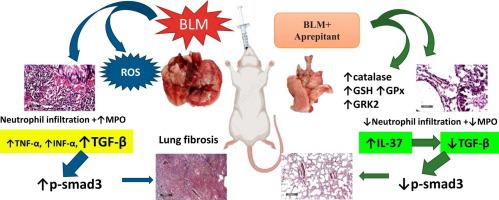Environmental Toxicology and Pharmacology ( IF 4.2 ) Pub Date : 2022-08-02 , DOI: 10.1016/j.etap.2022.103940 Mervat Z Mohamed 1 , Mohamed F Abed El Baky 2 , Merhan E Ali 3 , Heba M Hafez 1

|
Bleomycin is a well-recognized antineoplastic drug. However, pulmonary fibrosis (PF) is considered to be the principal drawback that greatly limits its use. Here, we sought to investigate ability of the neurokinin receptor 1 blocker, aprepitant, to prevent PF caused by bleomycin. Male adult Wistar rat groups were given a single intratracheal injection of bleomycin, either alone or in combination with aprepitant therapy for 3 or 14 days. Collagen deposition and a rise in transforming growth factor beta (TGF-β) immunoreactivity in lung tissue serve as evidence of bleomycin-induced PF. The serum levels of lactate dehydrogenase, alkaline phosphatase, and total antioxidant improved after aprepitant therapy.Additionally, it reduced the protein expressions of interferon alpha, tumor necrosis factor alpha, and lung lipid peroxidation. Moreover, aprepitant treatment led to an increase in the antioxidant indices glutathione, glutathione peroxidase, and catalase. Aprepitant is postulated to protect against bleomycin-induced PF by decreasing TGF-β, phosphorylating Smad3, and increasing interleukin 37, an anti-fibrotic cytokine, and G Protein-coupled Receptor Kinase 2. Aprepitant for 14 days considerably exceeded aprepitant for 3 days in terms of improving lung damage and having an anti-fibrotic impact. In conclusion, aprepitant treatment for 14 days may be used as an adjuvant to bleomycin therapy to prevent PF, mostly through inhibiting the TGF-/p-Smad3 fibrotic pathway.
中文翻译:

阿瑞匹坦通过抑制TGF-β/Smad3通路在博莱霉素诱导的大鼠肺纤维化中发挥抗纤维化作用
博来霉素是一种公认的抗肿瘤药物。然而,肺纤维化(PF)被认为是极大限制其使用的主要缺点。在这里,我们试图研究神经激肽受体 1 阻滞剂阿瑞匹坦预防博莱霉素引起的 PF 的能力。雄性成年 Wistar 大鼠组单次气管内注射博来霉素,单独或与阿瑞匹坦联合治疗 3 或 14 天。肺组织中的胶原沉积和转化生长因子 β (TGF-β) 免疫反应性的升高可作为博莱霉素诱导的 PF 的证据。阿瑞匹坦治疗后血清乳酸脱氢酶、碱性磷酸酶和总抗氧化剂水平得到改善。此外,它降低了干扰素α、肿瘤坏死因子α和肺脂质过氧化的蛋白表达。而且,阿瑞匹坦治疗导致谷胱甘肽、谷胱甘肽过氧化物酶和过氧化氢酶的抗氧化指数增加。假定阿瑞匹坦通过降低 TGF-β、磷酸化 Smad3 和增加白细胞介素 37(一种抗纤维化细胞因子)和 G 蛋白偶联受体激酶 2 来防止博莱霉素诱导的 PF。阿瑞匹坦 14 天显着超过阿瑞匹坦 3 天改善肺损伤和抗纤维化作用。总之,阿瑞匹坦治疗 14 天可作为博莱霉素治疗的辅助治疗,主要通过抑制 TGF-/p-Smad3 纤维化途径来预防 PF。并增加抗纤维化细胞因子白细胞介素 37 和 G 蛋白偶联受体激酶 2。在改善肺损伤和抗纤维化作用方面,阿瑞吡坦 14 天显着超过阿瑞吡坦 3 天。总之,阿瑞匹坦治疗 14 天可作为博莱霉素治疗的辅助治疗,主要通过抑制 TGF-/p-Smad3 纤维化途径来预防 PF。并增加抗纤维化细胞因子白细胞介素 37 和 G 蛋白偶联受体激酶 2。在改善肺损伤和抗纤维化作用方面,阿瑞吡坦 14 天显着超过阿瑞吡坦 3 天。总之,阿瑞匹坦治疗 14 天可作为博莱霉素治疗的辅助治疗,主要通过抑制 TGF-/p-Smad3 纤维化途径来预防 PF。











































 京公网安备 11010802027423号
京公网安备 11010802027423号